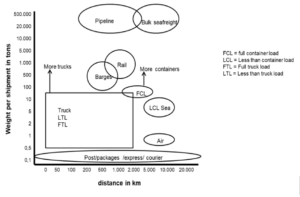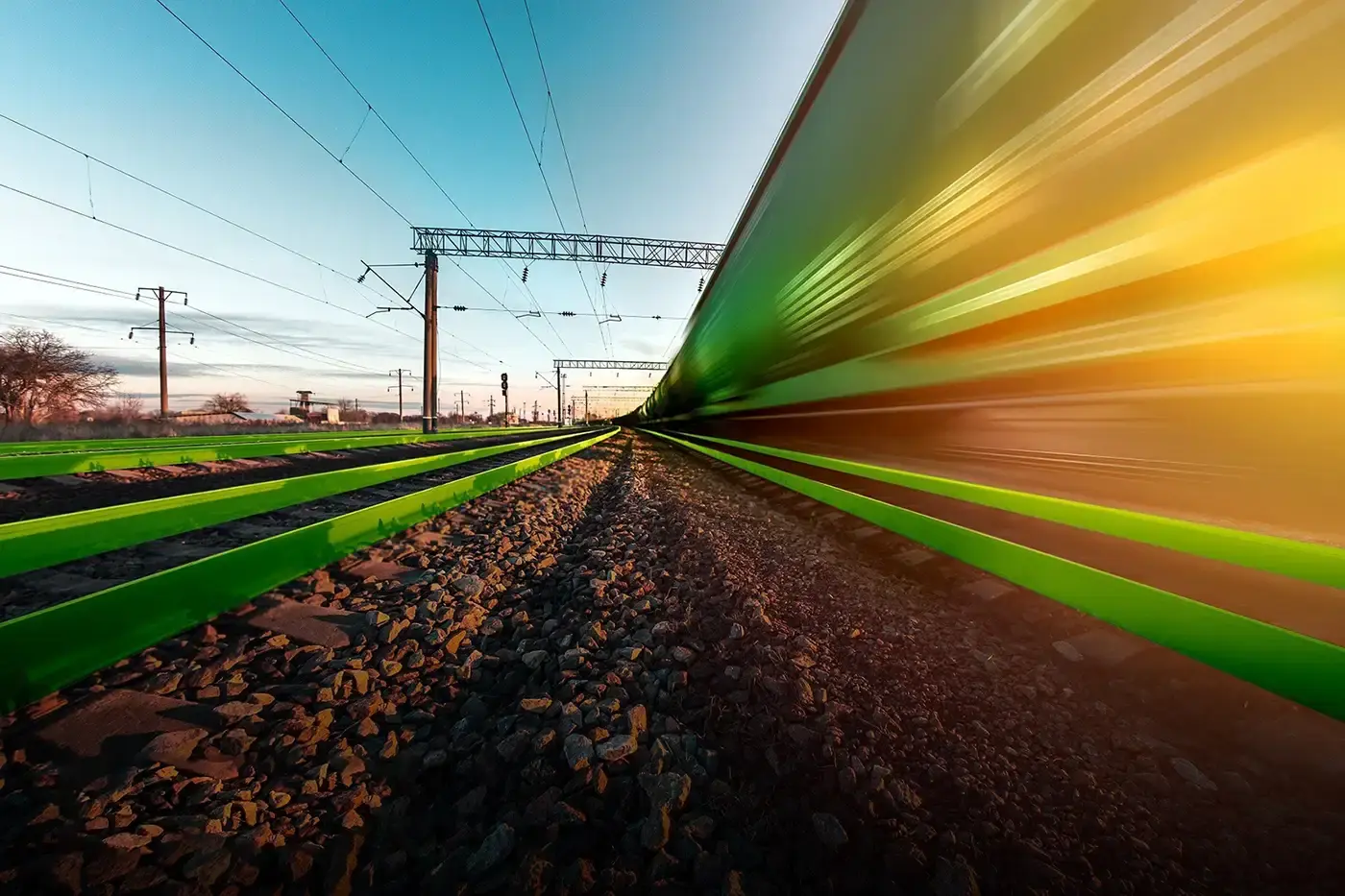The factors that count in the choice of mode can be divided into three categories:
Product characteristics
Value density
The value density of a product, such as a laptop, is the price per cubic meter or per ton, including packaging. This indicates how many laptops fit in a container or wagon, which can be calculated into the logistics cost per laptop. A recent trend is that more electronics and IT products from China are transported by rail instead of by deep sea or air freight. This is because deep sea transport often takes too long and air transport is too expensive per cubic meter or ton. Rail transport meets the demand for an option that is faster and more affordable than air freight but quicker than deep sea transport.
Life-time cycle
The shorter the life cycle of the product, the faster the transport must be to maximize the optimal period of the product’s life cycle. This is increasingly changing: a new mobile phone from Asia, with a relatively short life cycle and high competition, plus a significant investment, initially arrives in Europe by plane, then by train, and finally, the supply chain is stabilized with a constant deep sea supply. Thus, the first 45 days of the deep sea shipment are filled with sales of mobile phones that arrived by air and rail.
Packaging density
Packaging density indicates the number of handlings within a single mode, such as a wagon or truck. While a courier might have a packaging density of 500 (500 destinations in one delivery van), the packaging density of a container or freight wagon is often 1. The cargo from groupage wagons or containers is usually distributed with smaller delivery vans.
Volume-weight ratio
Air freight is highly concerned with volume-weight ratios: too bulky, and it doesn’t fit; too heavy, and the plane can’t take off (or land).
A significant advantage of rail transport is the ability to carry relatively heavy or bulky cargo. For intermodal transport, many Western European countries allow 44 tons instead of 40 tons via road if rail transport is used for the main route. It is the EU’s task to equalize these tonnages across the entire EU in the long term.
Appearance
The appearance of the product also influences the mode of transport. For example,kitchen appliances have been manufactured to dimensions of 60×60 cm. Think of kitchen cabinets, washing machines, refrigerators, freezers, etc. However, it was never considered that four appliances or cabinets, including packaging, do not fit side by side in a truck but do fit in a much wider wagon.
Shelf life
The shelf life of the product greatly determines the choice of mode, although there are increasing possibilities to extend the shelf life during transport, allowing for a slower mode. The lower the desired speed, the more modes are available, increasing competition, which is favorable for the price. Moreover, it is clear that the lower the speed, the higher the reliability.
Time pressure
Certain transport flows are subject to high time pressure and reliability. This is especially true for fresh products. Supermarkets want fresh goods on the shelves at opening hours, so goods must arrive and be distributed on time in the morning. Since transit times over 1000 km by rail are competitive with road transport, train transport is a formidable competitor to trucks. Rail transport must be planned earlier than road transport, so the problems lie more in time planning: “Can those strawberries be picked tomorrow or the day after tomorrow?”
Requirements of the shipper and/or customer or recipient
Product characteristics
These are the first and most important requirements and have already been mentioned above.
Recipient requirements
Consider delivery time, delivery frequency, lead times, and product cost price.
Storage possibilities
Where road transport typically involves two hours of loading, transport, and two hours of unloading, intermodal transport and rail freight offer more storage possibilities without using existing infrastructure.
Production methods
Just-In-Time (JIT) is a well-known production method that significantly influences the choice of mode.
Characteristics of the mode
Price
For many shippers, the price is the decisive factor among all parameters. There is a risk that transport buyers focus too much on the transport price alone and not enough on the total integrated logistics costs in the chain. This includes inventory management, ‘on site’ logistics, costs in pre- and post-transport, etc.
Reliability
Rail does not experience congestion like road transport or high and low water levels like inland waterways. However, rail can occasionally face strikes. These occur especially in specific countries like France, where strikes are regulated by law: they must be announced well in advance and cannot last longer than two consecutive days. This is to prevent stagnation in cargo flows. It is also essential to consider terminal congestion. While the train may be on time, if the loading unit is delayed, the cargo will still arrive late.
In contrast, rail is less vulnerable to weather conditions compared to other modes. For instance, the short sea route between the Netherlands and Spain passes through the Bay of Biscay. This part is known for its rough seas. It is not rare that this results in damage to the cargo. Therefore, some shippers consciously choose rail transport to and from Spain.
Frequency
The frequency of a rail connection is crucial for many transport flows. In particular, fresh products benefit from a high-frequency rail connection. Around 15 trains per day travel from the Netherlands to Italy. This offers more flexibility and certainty to logistics service providers. The general rule is: the shorter the distance, the higher the desired frequency. The longer the distance, the lower the frequency can be. For a train connection with Istanbul or Athens, one connection per week is often interesting enough for shippers. Frequency often factors into calculating speed.
Velocity
Given the same conditions, rail transport can be faster than any other land mode. When a train to Italy departs at the same time as a truck, the train is usually faster because it does not have to adhere to work and rest times. For ships, planes, and trains (over longer distances), the average speed is close to the actual speed. It is important to keep in mind that pre- and post-transport, waiting times, handlings, and frequencies significantly affect throughput speed.
Sustainability
Since the Paris Agreement, more shippers are looking for sustainable transport solutions to reduce CO2 emissions. While transport costs are often decisive, sustainability is becoming increasingly important for various shippers. In this regard, intermodal rail transport has far better prospects compared to other unimodal solutions. Rail is the most sustainable option compared to sea or inland waterway transport. More information about the sustainability of rail transport can be found here: (link to rail benefits).
Risk
Modalities are often compared based on risk. When delving deeper, it often comes down to a gut feeling that one mode is much riskier than another. But what risks are we talking about? You are generally insured against cargo risks such as theft or transport damage, and if that is not enough, you can get additional insurance. Transport through “certain, vague” countries is also considered risky. Shippers used to driving through these countries have less of this feeling.
Weight/ distance relationship

Want to know more?
Would you like to learn more about the parameters for modal choice and how this is calculated within rail freight transport? Check out our page on the Rail Cargo Academy.

